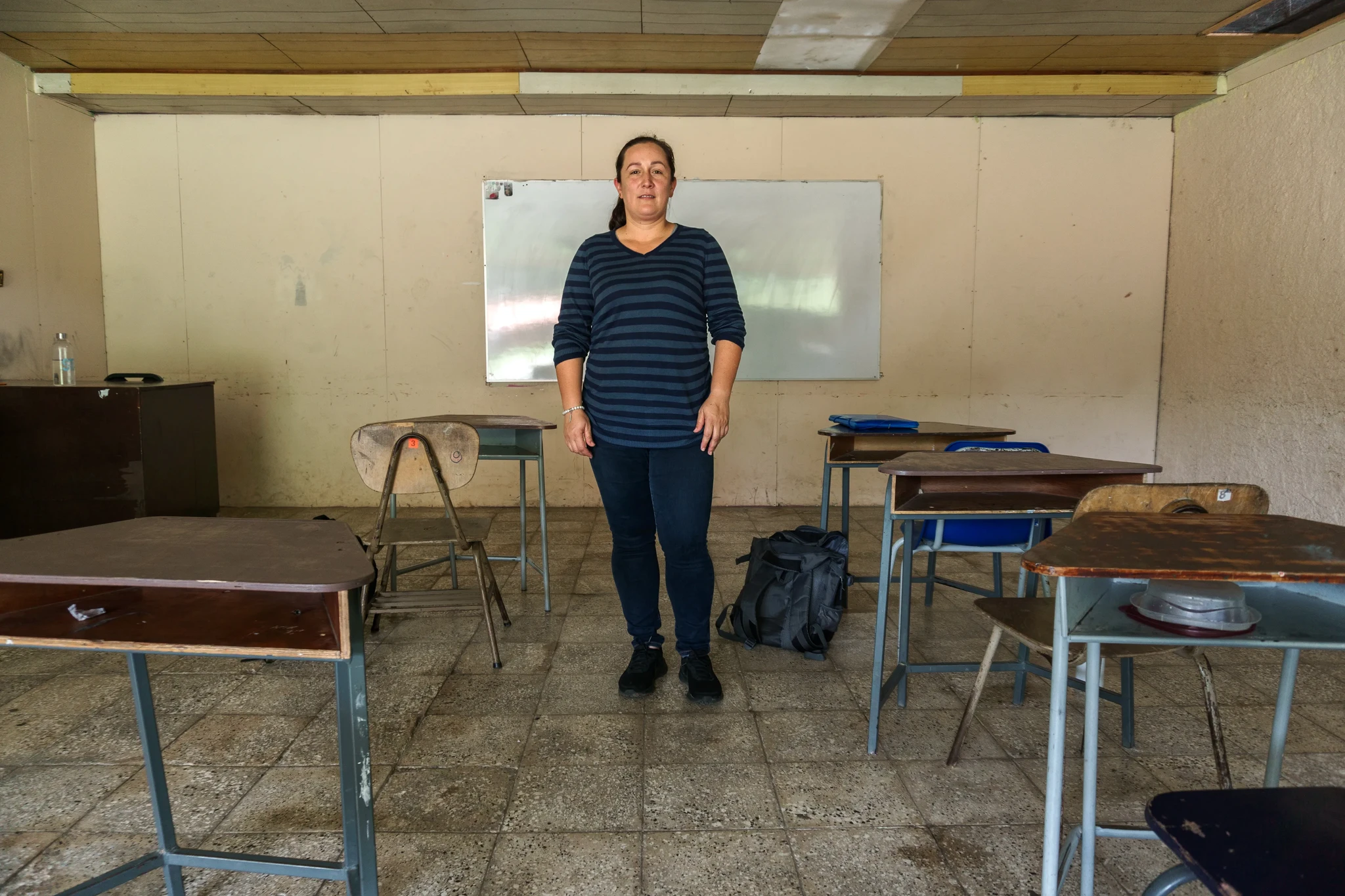

STORY
6
.
1
No Regional Exodus
Of 8.2 million climate displaced persons, nearly 6 million will stay in their home countries, with few leaving the region.



STORY
6
.
1
No Regional Exodus
Of 8.2 million climate displaced persons, nearly 6 million will stay in their home countries, with few leaving the region.



STORY
6
.
1
No Regional Exodus
Of 8.2 million climate displaced persons, nearly 6 million will stay in their home countries, with few leaving the region.

Figure 1
Climate mobility across different scales in the Greater Caribbean by 2050
Climate out-migration (in millions) at the local, national, and international level for different climate scenarios by 2050.
SSP1-RCP2.6
SSP2-RCP4.5
SSP3-RCP7.0
Source: GCCMI Greater Caribbean Climate Mobility Model, 2024.

Figure 1
Climate mobility across different scales in the Greater Caribbean by 2050
Climate out-migration (in millions) at the local, national, and international level for different climate scenarios by 2050.
SSP1-RCP2.6
SSP2-RCP4.5
SSP3-RCP7.0

Source: GCCMI Greater Caribbean Climate Mobility Model, 2024.
Figure 1
Climate mobility across different scales in the Greater Caribbean by 2050
Climate out-migration (in millions) at the local, national, and international level for different climate scenarios by 2050.
SSP1-RCP2.6
SSP2-RCP4.5
SSP3-RCP7.0

Source: GCCMI Greater Caribbean Climate Mobility Model, 2024.
Most people forced to move due to climate change impacts are projected to resettle within their home countries. Most of this internal climate mobility will occur in large countries such as Mexico and Colombia, where people can escape climate hazards without crossing a national border. Smaller nations, like Suriname and The Bahamas, will see a larger share of their populations forced to move. In Venezuela and the Dominican Republic internal climate mobility will be high both in absolute numbers and as a share of their national populations.
Most people forced to move due to climate change impacts are projected to resettle within their home countries. Most of this internal climate mobility will occur in large countries such as Mexico and Colombia, where people can escape climate hazards without crossing a national border. Smaller nations, like Suriname and The Bahamas, will see a larger share of their populations forced to move. In Venezuela and the Dominican Republic internal climate mobility will be high both in absolute numbers and as a share of their national populations.
Most people forced to move due to climate change impacts are projected to resettle within their home countries. Most of this internal climate mobility will occur in large countries such as Mexico and Colombia, where people can escape climate hazards without crossing a national border. Smaller nations, like Suriname and The Bahamas, will see a larger share of their populations forced to move. In Venezuela and the Dominican Republic internal climate mobility will be high both in absolute numbers and as a share of their national populations.
Figure 2
The impact of internal movement will be greater for some countries than others. Suriname will see the greatest share of its population relocate internally.
Distribution of internal climate mobility as a proportion of the total population by country, cumulative for 2050.
Local
National
Source: GCCMI Greater Caribbean Climate Mobility Model, 2024.

Figure 2
The impact of internal movement will be greater for some countries than others. Suriname will see the greatest share of its population relocate internally.
Distribution of internal climate mobility as a proportion of the total population by country, cumulative for 2050.
Local
National

Source: GCCMI Greater Caribbean Climate Mobility Model, 2024.
Figure 2
The impact of internal movement will be greater for some countries than others. Suriname will see the greatest share of its population relocate internally.
Distribution of internal climate mobility as a proportion of the total population by country, cumulative for 2050.
Local
National

Source: GCCMI Greater Caribbean Climate Mobility Model, 2024.
People who move across borders will mainly go to traditional destination countries outside the region.
People who move across borders will mainly go to traditional destination countries outside the region.
People who move across borders will mainly go to traditional destination countries outside the region.
Approximately 30% of people who move permanently due to climate change in the Greater Caribbean by 2050 will resettle abroad, amounting to 2.4 million people under the Rocky Road scenario. The number of people who move across borders could be significantly smaller, only about 1.5 million, if global warming is limited to below 2ºC under the Middle Road scenario.
International climate mobility will be highly relevant for some countries in the region. Following current emigration trends in pursuit of education and work abroad, most people that move away from SIDS are projected to leave the region. The populations of Suriname and Guyana could shrink by up to 5% due to cross-border climate mobility by 2050. The largest share of cross-border climate mobility from the Greater Caribbean region is expected to come from Mexico, which will still be smaller than the amount of people that move within Mexico due to climate impacts.
Approximately 30% of people who move permanently due to climate change in the Greater Caribbean by 2050 will resettle abroad, amounting to 2.4 million people under the Rocky Road scenario. The number of people who move across borders could be significantly smaller, only about 1.5 million, if global warming is limited to below 2ºC under the Middle Road scenario.
International climate mobility will be highly relevant for some countries in the region. Following current emigration trends in pursuit of education and work abroad, most people that move away from SIDS are projected to leave the region. The populations of Suriname and Guyana could shrink by up to 5% due to cross-border climate mobility by 2050. The largest share of cross-border climate mobility from the Greater Caribbean region is expected to come from Mexico, which will still be smaller than the amount of people that move within Mexico due to climate impacts.
Approximately 30% of people who move permanently due to climate change in the Greater Caribbean by 2050 will resettle abroad, amounting to 2.4 million people under the Rocky Road scenario. The number of people who move across borders could be significantly smaller, only about 1.5 million, if global warming is limited to below 2ºC under the Middle Road scenario.
International climate mobility will be highly relevant for some countries in the region. Following current emigration trends in pursuit of education and work abroad, most people that move away from SIDS are projected to leave the region. The populations of Suriname and Guyana could shrink by up to 5% due to cross-border climate mobility by 2050. The largest share of cross-border climate mobility from the Greater Caribbean region is expected to come from Mexico, which will still be smaller than the amount of people that move within Mexico due to climate impacts.
Figure 3
The United States will be the top destination for people moving due to climate change
Top destinations for cross-border climate mobility under the Rocky Road scenario (SSP3-RCP7.0) by 2050.
United States of America
Canada
Spain
Costa Rica
Netherlands
Other
Source: GCCMI Greater Caribbean Climate Mobility Model, 2024.

Figure 3
The United States will be the top destination for people moving due to climate change
Top destinations for cross-border climate mobility under the Rocky Road scenario (SSP3-RCP7.0) by 2050.
United States of America
Canada
Spain
Costa Rica
Netherlands
Other

Source: GCCMI Greater Caribbean Climate Mobility Model, 2024.
Figure 3
The United States will be the top destination for people moving due to climate change
Top destinations for cross-border climate mobility under the Rocky Road scenario (SSP3-RCP7.0) by 2050.
United States of America
Canada
Spain
Costa Rica
Netherlands
Other

Source: GCCMI Greater Caribbean Climate Mobility Model, 2024.
Most international climate mobility originating in the region can be expected to go to destinations outside the Greater Caribbean, following historically significant migration channels to North America and Europe. The young (20-39 year olds) are expected to be overrepresented in those international movements. The United States will be the top destination for cross-border climate mobility from the Greater Caribbean region. Costa Rica will be the top destination for cross-border climate mobility within the region.
Climate mobility makes up a small fraction of total international mobility within and from the region over the next few decades. It will account for less than 10% of the total, regular mobility that is expected to reach the United States by 2050 (Rocky Road scenario). Other drivers, such as employment and education are likely to remain key motivations for emigration from the Greater Caribbean to other regions of the world.
Most international climate mobility originating in the region can be expected to go to destinations outside the Greater Caribbean, following historically significant migration channels to North America and Europe. The young (20-39 year olds) are expected to be overrepresented in those international movements. The United States will be the top destination for cross-border climate mobility from the Greater Caribbean region. Costa Rica will be the top destination for cross-border climate mobility within the region.
Climate mobility makes up a small fraction of total international mobility within and from the region over the next few decades. It will account for less than 10% of the total, regular mobility that is expected to reach the United States by 2050 (Rocky Road scenario). Other drivers, such as employment and education are likely to remain key motivations for emigration from the Greater Caribbean to other regions of the world.
Most international climate mobility originating in the region can be expected to go to destinations outside the Greater Caribbean, following historically significant migration channels to North America and Europe. The young (20-39 year olds) are expected to be overrepresented in those international movements. The United States will be the top destination for cross-border climate mobility from the Greater Caribbean region. Costa Rica will be the top destination for cross-border climate mobility within the region.
Climate mobility makes up a small fraction of total international mobility within and from the region over the next few decades. It will account for less than 10% of the total, regular mobility that is expected to reach the United States by 2050 (Rocky Road scenario). Other drivers, such as employment and education are likely to remain key motivations for emigration from the Greater Caribbean to other regions of the world.





